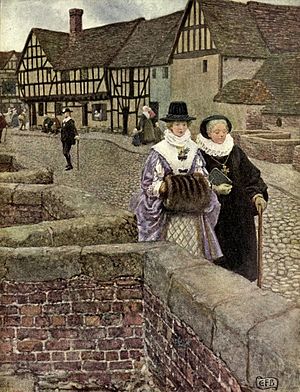Thomas Ford (composer) facts for kids

Thomas Ford was an English composer, lutenist (someone who plays the lute), viol player, and poet. He lived a long time ago, from about 1580 until he was buried on November 17, 1648. He was a very talented musician during a time when music was changing a lot.
His Life and Work
Thomas Ford worked for the royal family in England. He was a musician for Henry Frederick, Prince of Wales, who was the son of King James I. Prince Henry sadly died in 1612.
After that, Ford continued to work for the royal family. He was a musician for Prince Charles from 1617 to 1625. This Prince Charles later became King Charles I. Thomas Ford then worked for King Charles I from 1626 until 1642. This was when the English Civil War began, a big conflict in England.
Thomas Ford made his will (a legal document about his wishes after he died) on November 12, 1648. He was buried in a church called St. Margaret's in Westminster on November 17, 1648. We don't know the exact day he passed away, but it was around that time.
What Music Did He Write?
Thomas Ford wrote many different kinds of music. He created:
- Anthems: These are special songs, often for church, sung by three to six voices.
- Sacred canons: These are like round songs, but for church, with four parts.
- Partsongs: These are songs for several voices. He wrote 35 of them!
- Fantasias: These are musical pieces that allow the composer to be very creative. He wrote six of these for five parts.
- Other pieces for viols: Viols are old string instruments, a bit like cellos or violins.
His most important collection of music was probably a book called Musicke of Sundrie Kindes, which means "Music of Different Kinds." It was published in London in 1607 and had two main parts.
The first part of the book included lute ayres. Ayres are songs for a voice, often with a lute. These were described as "Aries for 4 voices to the Lute, Orphorion, or Basse-viol, with a Dialogue for two Voices." This means they could be sung by four voices with a lute, orphorion (another old instrument), or a bass viol. Some also had a dialogue for two voices.
The second part of his book contained dances. These included "Pavens, Galiards, Almaines, Toies, Jigges, Thumpes, and such like." These were lively dances for different combinations of viols. Many of his ayres (songs) were given in two versions. One version was for a voice or voices with a lute. The other was for four equal voices.
One interesting thing about his music for the viol is that he sometimes used a special sound effect. It was a heavy pizzicato "thump." This meant plucking the strings with the first and second fingers of the left hand, which was unusual for the time.
Two of his famous songs from this collection are "Since first I saw your face" and "There is a Lady sweet and Kind." The song "Since first I saw your face" was even set to music again much later, in 1942, by another composer named Roger Quilter. Thomas Ford also put music to a poem called 'Yet if His Majesty Our Sovereign Lord'.
Some of his church music, found in collections from 1614 and 1620, was also special. It included something called a basso continuo. This was a musical style feature that was common in Baroque music on the European continent. However, it was quite new and appeared later in England.
Thomas Ford was an important musician who came before other famous composers like Henry Lawes. He is often mentioned alongside John Dowland as a leading figure in music from that time.

